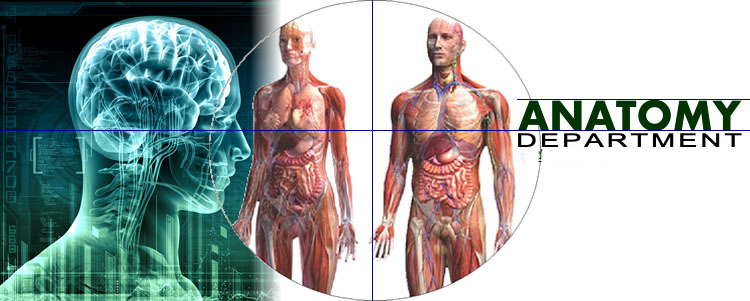Anatomy lecture theatre for stratified well planned lecture sessions in gross Anatomy, Histology, Developmental Anatomy, Neuroanatomy, Genetics, Surface Anatomy and Radiology.
Dissection hall.
Demonstration rooms
Histology slide laboratory .
Seminar rooms
Gross Anatomy and Embryology museum
Radiography section.
Osteology laboratory
Facilities for all round professional developmental for faculty members by high class library
Development and renovating the existing build up area of the Department.
The various infrastructure of the Department can be broadly dismembered as:
A. Equipments for didactic lecture sessions.
B. Equipments for demonstration and practical sessions.
1. Lecture theatre – 01 with seating capacity of 200
a. Demonstration rooms – 02 with seating capacity of 50
2. USB/HDMI/Cordless projectors - 02
b. Osteology sets - 15
3. Computer systems - 02
c. Articulated Skeleton - 03
4. Laptops - 02
d. Disarticulated skeleton - 05
e. Fetal bone sets – 02
f. Gross Anatomy demonstration charts – 60
.-
C. Dissection hall
D. Histology practical hall
1. Large sized Cadaver tables - 10
a. Granite mounted histology practical tops and tables - 10
2. Small sized cadaver tables - 05
b. Monocular student microscope -
3. Cadavers – 05**
c. Binocular microscope
4. Band saw – 01
d. Projection microscope – 01
5. Meat cutting machine – 01
e. Human histology slide set – 5 sets each with 60 slides
6. Gross Anatomy dissection charts – 40
.
7. Student lockers - 50
.
8. Unmounted wet dissected upper extremity – 06**
.
9. Unmounted wet dissected organs – 20**
.
** Subject to availability, as many of these are utilized for student teaching, regular dissection and internal and University examination schedules.
E.Museum(With student catalogue – 05)
F. X ray viewing lobby
1. Wet mounted specimen - 90
1. Cold storage cabinets = 02 each with 4 chambers
2. Dry mounted specimen - 20
2. Electric embalming machine 01
3. Embryology wet mounted specimen - 10
3. Embalming solution in storage tanks
4. Skeletons articulated - 02
.
5. Models – 20
.
6. Charts – 20
.
G.Research room)
.
a. Dissection microscope – 05
.
b. Research microscope – 05
.
c. Paraffin bath – 02
.
d. Rotary microtome – 01
.
e. Hot air oven with temperature control– 01
.
f. Hot plates – 01
.
g. Slide warmer – 01
.
h. Magnetic stirrer – 01
.
i. Slide cabinets – 05 each with 1000 capacity
.
j. Electronic balance – 01
.
k. Histology charts – 60
.
l. Glass ware – 40
.
m. Refrigerator – 01
.
n. Diamond pencil – 05
.
o. Color marking pencil – 05
.
p. Hematoxylin and Eosin stains bottles
.
I. Anthropometrics instruments
J. Library section
a. Vernier caliper - 02
1. Books – 150
b. Goniometer – 02
2. Journals - 05
c. Mandibulometer - 02
.
